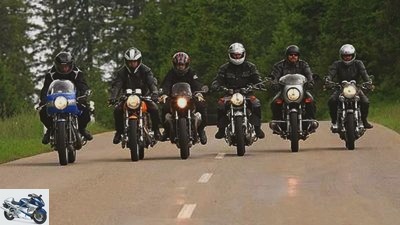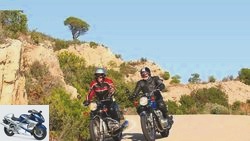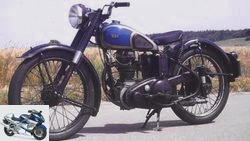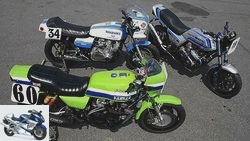Menus
- Europe wheel
- Ducati 900 SS
- Laverda 1000 3C and 750 SF
- Moto Guzzi Le Mans, BMW R 90 S.
- Norton Commando
- Conclusion, technical data

wolf
On the move: classics of the 70s
Europe wheel
Content of
In the mid-1970s, the European motorcycle industry tried to compete with the superiority of the Japanese manufacturers, partly with new and partly with traditional concepts.
D.he battle for shares in the German motorcycle market had long since been decided in favor of Japan around 1975. Nevertheless, traditional European manufacturers tried to assert themselves in the prestigious upper class with their top models. Above all BMW: The flagship of Bavaria, the R 90 S, expanded the two-cylinder boxer series upwards with a wealth of equipment.
Several Italian manufacturers fought for market share with very different concepts: Just a few years earlier, Ducati had introduced the vertical shaft twin-cylinder with 90-degree V-engine, which revived the brand primarily through sporting success. Moto Guzzi also relied on a 90-degree V2 engine, albeit with a lengthways crankshaft. It had already made its debut in the V7 and provided propulsion for everything from tourers to sports bikes. Laverda in Breganze also relied on its own concept: in 1973, the two-cylinder in-line cylinders with 750 cm³ were joined by a massive three-cylinder with 1000 cm³, two overhead camshafts and an unusual 180 degree crank pin offset.
And in the motorcycle country par excellence, in England? This was where the struggle for survival raged most violently. At least Triumph and Norton still offered models in the large displacement classes. The classic Norton parallel twin was still based on the post-war two-cylinder and had increased over the years to 850 cc. With the Commando, the Isolastic elastic engine mount was incorporated into the chassis. It should keep the powerful vibrations of the twin away from the driver.
While the majority of experienced motorcyclists are very likely to have driven one of the Far Eastern multi-cylinders at some point in their lives, the chance of experiencing a European big bike from the 1970s is far lower. Many dreamed of a bevel Ducati in its sportiest form, a three-cylinder Laverda or a BMW R 90 S, but only a few were able to make this dream come true. Only a few British bikes like Norton Commando were on the wish list of motorcycle enthusiasts, and today the majority of the two-wheeled gems are in collectors’ hands – so hardly a chance of being able to move one of the rare parts in the wild.
But it really does exist, this opportunity: Jurgen Lauer offers guided tours on exactly those classics. MOTORRAD CLASSIC took the opportunity and drove the top European motorcycles of the 1970s through the Black Forest.
They are well prepared for the exit. The BMW R 90 S, largely in its original condition with only minor technical changes, for example Koni struts, represents the German parliamentary group. Several opponents from Italy face the competition. The most fiery of them is the Ducati 900 SS, i.e. the sporty vertical shaft V2, which replaced the 750 version in 1975. It is also slightly modified, has a gel battery under the aluminum tank, so the side covers can be omitted.
There are two representatives for Laverda: a modified 750 SF, which is optically based on the SFC with its one-man hump, clip-on handlebars and orange paintwork, and a 3C from 1976, largely in its original condition and also equipped with a sporty one-man hump. A Moto Guzzi Le Mans is a bit out of line when it comes to timing. On the version with 1000 cm³, which has been heavily revised by Tuner HTM, angular ribbed cylinders indicate a Le Mans III, which came onto the market in 1982. In comparison, the English Lady is also almost standard: except for the high-shoulder rims made of light metal, the American version of the Norton Commando 850 Roadster from 1976, i.e. already with an electric starter, corresponds to the series.
Ducati 900 SS
wolf
Ducati 900 SS.
The characters could hardly be more different: from the touring BMW to the super sporty Ducati, the European top league of that time will once again demonstrate its qualities. Once again the Ducati 900 SS proves to be a driving machine of the purest water. Anything but softened, it embodies the thoroughbred, uncompromising sports motorcycle of the 70s. Even reaching for the clutch leaves no doubt: it’s time to grab.
The sitting posture looks as super sporty as the type designation; The upper body stretched flat over the tank, the arms stretched forward to the handlebars, and the legs up and far back on the footrests, the driver crouches on the seat hump in the Ducati as if to jump – once he has it to life Awakened, because the Ducati is uncompromising in this respect too: No gentle thumb pressure on the starter button, but a courageous kick on the kickstarter lever is the order of the day. If it is successful, intense Italian hard rock à la Gianna Nannini sounds with a volume that increases in proportion to the speed.
The V2 breathes in unmistakably through the open air funnels of the Dell’Ortos and exhales just as unmistakably through the Conti bags. The dull rumble from low speeds turns into hard, pressed shooting at higher speeds, underlaid by the rattling, scraping sound of the desmodromic. The 900 SS not only maintains its strong acoustics, but also in terms of performance: In the lower speed range, it is noticeably livelier than its 750 predecessor and then turns willingly into the red area without annoying vibrations.
Grabbing also applies to the handlebars. The Ducati does not particularly like tight bends or serpentines, the elongated seating position and the high steering forces do not make it really fun to drive. It only opens up to the driver in broad arcs, because then the Ducati feels in its element, stubbornly and steadfastly on its way – as stubbornly as the driver has to pull the brake lever when necessary. Although the pressure point does not feel as hard as a bone, despite the steel-flex brake lines, as is known from Supersport Ducatis, and the brake can be adjusted slightly better, courageous use of force from the forearm is also required when anchoring.
Laverda 1000 3C and 750 SF
wolf
Laverda 1000 3C.
The Laverda 1000 3C suggests power even when it is stationary, it stands there as massive as a rock, the mighty, towering three-cylinder with double cam head in the frame. Despite the sporty single hump, which is lower than the standard seat, the rider does not sit in the motorcycle, as is the case with the Ducati, but sits enthroned on top. The variable ergonomics suits it: In this example, the typical handlebar, each with two gears, is positioned quite touristically above the fork bridge. This creates better contact with the motorcycle than with the handlebars, which are usually arranged in a sporty, deep manner.
The three-cylinder Laverda also requires a hard, gripping clutch hand, and the mechanics of the gnarled right-hand gear shift is most likely to move with a targeted kick to change gears. With 981 cm³ and 80 hp, the three-cylinder was one of the most powerful and powerful motorcycles ever on its debut; Today it still convinces with its acceleration and turning ability. His expressions of life give those who are not familiar with the unusual crankshaft offset with a 180 degree crank pin offset puzzles about the number and arrangement of cylinders: acoustically, a mixture of two-cylinder in-line and V-engines, accompanied by relatively heavy vibrations – and that despite the special crankshaft.
In terms of driving behavior, the Laverda does not show the consistency of the Ducati: It also wants to be steered with vigor, even requires less steering force in tight corners than its competitor from Bologna, but does not act with its stability in fast corners. Your slight restlessness is always predictable, but it tarnishes the clean line. The brakes require firm grip, but still feel relatively doughy. She, too, is a motorcycle for individualists: unconventional with a strong character.
At least in this respect it does not differ from its twin-cylinder sister 750 SF. In her orange outfit, equipped with stub handlebars and a hump seat, you could at first glance actually take it for an SFC; But the connoisseur will quickly notice fundamental differences such as the frame and tank.
In terms of the seating position, it is at least very similar to its sporty counterpart: the driver sits stretched out in the Laverda, even if not as uncompromisingly as in the Ducati. Unlike the 3C, confidence in the chassis is quickly established. The once again perfectly appealing Ceriani fork and the rigid chassis help the two-cylinder Laverda to achieve high steering precision and driving stability in fast corners. She circles slow corners rather reluctantly and wants to be kept on course with force on the handlebars.
Always present, the two-cylinder shakes vigorously even at low engine speeds; upwards it increases so much that hands, legs and seat are massaged vigorously over long distances. Higher speeds are not the strength of the SF engine anyway; in these regions he seems far less willing to perform than his sporty brother, who was used in the SFC.

motorcycles
On the move: BMW R 75/5, Honda CB 750
The summer of 69
read more
Moto Guzzi Le Mans, BMW R 90 S.
wolf
BMW R 90 S..
The Moto Guzzi Le Mans has slimmed down weight and built up muscles in an all-round fitness program. Thanks to the aluminum tank, a small hump bench and weight optimization of many components, it not only looks more puristic and well-trained on the outside than a standard Le Mans of the first series, it actually is.
Your heavily redesigned engine with 1000 cm³, special connecting rods and pistons, redesigned heads and an exhaust system with thick manifolds draws from the full and marches on from idle speed to the red area. The Guzzi develops a wide range of sounds from guttural thumping to distinctive thunder. Is that still legal? Ah, con questo! As is typical for the brand, the Le Mans is more manageable than the Italian competition without sacrificing driving stability.
In comparison, the BMW R 90 S appears far more cosmopolitan, downright diplomatic. She appreciates the moderate sound and cultivates selected manners; Their seating position and the handlebar cover offer excellent conditions for long-term tourist driving pleasure. With an upright upper body you sit relaxed from the first moment, and the narrow, inexpensive cranked handlebars lie comfortably in your hand.
Dealing with the Bavarian is just as problem-free: the boxer engine willingly pulls through even from low revs, offers a lot of torque in the middle and only appears to be a bit strained in the upper rev range. Acoustically, he climbs the speed ladder with the typical, rhythmic humming, which is never intrusive, but always cautious, even calming in the long run; the vibrations are kept within narrow limits.
With almost exemplary handiness, the R 90 S outdoes the Italian competition in the labyrinth of curves; at most, bumps in fast corners introduce slight unrest into the chassis. This fits into the image of a gentleman boxer; even Henry Maske showed small weaknesses. As is typical for BMW, the gearbox turns a bit wobbly and thanks the driver if he takes a little more time to change gears.
The brake lever activates the master brake cylinder under the tank with a cable. It exerts hydraulic pressure on the single-piston swivel calipers of the double disc brake at the front, which results in a somewhat doughy constellation. A BMW newcomer has to get used to the famous elevator effect, i.e. the lifting of the rear when accelerating, as well as the load change reaction around the longitudinal axis; die-hard BMW drivers no longer notice them.
Norton Commando
wolf
Norton Commando.
Very British follows in typical German: classic English motorcycle construction with two-cylinder synchronous rotor, sweeping primary cover and separate gearbox. The seating position also clearly indicates the country of origin of the Norton: Relaxed behind the wide and high handlebars, upper body upright and legs bent almost at right angles, it is like sitting in a Victorian sofa.
When the starter button is pressed, the twin buzzes and exhales through the classic bags with a sonorous bass. With increasing speed, its timbre changes, swells to a rumble of thunder. Then only one tone dominates, no longer ladylike: the Norton.
As vehement as the Langhuber is acoustically, it also steps in: From idle the Commando pulls through resolutely, and the competition is left behind in the lower and middle speed range. It doesn‘t matter that the twin acts much more slowly at high speeds and it doesn’t make sense to torment it all the way to the red zone. Enjoy the full torque and shift up early – or let the engine speed drop in fourth, the last gear: Both are downright playful and determine the pace.
Even the vibrations typical of British synchronous motors are kept within limits. At low speeds, the twin sometimes unwillingly shakes itself in its elastic mounting and, with increasing speed, only allows soft, never annoying vibrations to get through to the driver.
Riding the Norton is as relaxed as the seated position because of its handiness: guided on the wide handlebars, it loosely circles around hairpin bends and pulls lightly out again after opening the throttle grip. The individual disc brake in the front wheel reacts to the pull on the lever with impressive power. Little hand strength results in perfectly adjustable, sensitively controllable deceleration up to the tire grip limit and thus puts the rest of the Black Forest travel group in the shade. The reason: The brake caliper is originally cast in one piece, which is now proclaimed a modern achievement and is called monobloc. It shines with high rigidity and offers the best prerequisites for fine-tuning, for example steel braided lines and a hand pump with modified hydraulic transmission.
The fact that the English lady shakes capriciously in fast corners is at best a downer, because they are simply not her territory. In most situations, it ensures absolute easy going in its most beautiful form, almost like an automatic motorcycle.
At the end of a long day in the varied Black Forest, the drivers of the six classics have gained a whole lot of impressions and experiences. The biggest and most positive surprise is certainly the Norton, whose unproblematic driving behavior does not convince with the cliche of an English motorcycle, especially since it did not leave a single oil stain under it all day. Under the new German keyword “cruising”, the Commando is the motorcycle of the hour.

classic
On the move: BSA C11 de Luxe
For the sake of simplicity
read more
Conclusion, technical data
wolf
Ducati, Laverda, Norton, Moto Guzzi, BMW and Laverda again: the top European league of the 70s.
Ironically, the candidate from Bavaria likes her Prussian motto "Be more than seem": As usual, smooth, almost conspicuously inconspicuous, with at most minor blemishes in the overall impression, the BMW R 90 S is once again the all-rounder and the best tourer.
The Italian motorcycles are completely different; Restraint is not their thing: the Ducati 900 SS is super sporty, the Laverda 750 SF can still keep up thanks to its great chassis. The Moto Guzzi Le Mans and especially the Laverda 1000 3C are just as powerful as they are full of character. All four are headstrong, they are undoubtedly one of the most colorful representatives of their time.
Should we have aroused your curiosity with this story to the point that you want to drive one or the other of the presented classics yourself – the chances that you can do that are good.
BMW R 90 S.
Engine: Air-cooled two-cylinder four-stroke boxer engine, two valves each, a camshaft below, bumpers and rocker arms; Bore x stroke 90 x 70.6 mm, 898 cm³, 67 hp at 7000 rpm
Power transmission: Single-disc dry clutch, five-speed gearbox, cardan
Landing gear: Double loop frame made of tubular steel, telescopic fork, two-arm swing arm, two springs-
legs, wire-spoke wheels, tires: 3.25 H 19 / 4.00 H 18, double disc brake at the front, Ø 256 mm, single-piston swivel calipers, drum brake at the rear.
Measurements and weight: Wheelbase 1445 mm, weight 226 kg with a full tank.
Driving performance: Top speed 200 km / h.
Manufacturer: BMW AG, Munich
Ducati 900 SS
Engine: Air-cooled two-cylinder four-stroke 90-degree V-engine, two valves each, actuated desmodromically, one overhead camshaft, rocker arm, bore x stroke 86 x 74.4 mm, 864 cm³, 75 hp at 7500 / min
Power transmission: Multi-disc oil bath clutch, five-speed gearbox, chain
Landing gear: Backbone frame, telescopic fork, two-arm swing arm, two spring struts, wire-spoke wheels, tires: 3.50 H 18 / 4.00 H 18, double disc brake at the front, Ø 280 mm, two-piston fixed calipers, disc brake at the rear, 225 mm, two-piston fixed caliper
Mass and weight: Wheelbase 1480 mm, weight 210 kg with a full tank
Driving performance: Top speed 220 km / h
Manufacturer: Ducati Meccanica S.p.A., Bologna, Italy
Laverda 750 SF
Engine: Air-cooled two-cylinder four-stroke in-line engine, two valves each, one overhead camshaft, rocker arm, bore x stroke 80 x 74 mm, 744 cm³, 65 hp at 7000 / min
Power transmission: Multi-disc oil bath clutch, five-speed gearbox, chain
Landing gear: Backbone frame, telescopic fork, two-arm swing arm, two spring struts, wire-spoke wheels, tires: 3.50 H 18 / 4.00 H 18, double disc brake at the front, Ø 280 mm, disc brake at the rear
Weight: 228 kg
Driving performance: Top speed: 195 km / h
Manufacturer: Moto Laverda, pp. A., Breganze, Italy
Laverda 1000 3C
Engine: Air-cooled three-cylinder four-stroke in-line engine, two valves each, two overhead camshafts, bore x stroke: 75 x 74 mm, 981 cm³, 80 hp at 7300 rpm
Power transmission: Multi-disc oil bath clutch, five-speed gearbox, chain
Landing gear: Double loop frame, telescopic fork, two-arm swing arm, two suspension struts, wire-spoke wheels, tires: 4.10 H 18 / 4.25 H 18, double disc brake at the front, Ø 280 mm, two-piston fixed calipers, duplex drum brake at the rear, Ø 230 mm
Measurements and weight: Wheelbase 1486 mm, weight with a full tank 243 kg
Driving performance: Top speed: 210 km / h
Manufacturer: Moto Laverda S.p.A., Breganze, Italy
Moto Guzzi Le Mans
Engine: Air-cooled two-cylinder four-stroke 90-degree V-engine, two valves each, a camshaft below, bumpers and rocker arms, bore x stroke 88 x 78 mm, 949 cm³, approx. 80 HP
Power transmission: Two-disc dry clutch, five-speed gearbox, cardan
Landing gear: Double loop frame, telescopic fork, double swing arm, two suspension struts, wire-spoke wheels, tires: 3.50 H 18 / 4.00 H 18, double disc brake at the front, Ø 280 mm, disc brake at the rear
Weight: 210 kg
Manufacturer: Moto Guzzi S.E.I.M.M. Mandello del Lario, Italy
Norton Commando
Engine: Air-cooled two-cylinder four-stroke in-line engine, two valves each, a camshaft below, bumpers and rocker arms, bore x stroke 77 x 89 mm, 829 cm³, 58 HP at 5900 rpm
Power transmission: Multi-disc dry clutch, four-speed gearbox, chain
Landing gear: Double loop frame, telescopic fork, double swing arm, two spring struts, wire spoke wheels, tires: 4.10 x 19 / 4.10 x 19, front disc brake, Ø 270 mm, two-piston fixed calliper, rear disc brake, Ø 270 mm, two-piston fixed calliper.
Measurements and weight: Wheelbase: 1440 mm, weight with a full tank: 218 kg
Driving performance: Top speed 190 km / h
Manufacturer: Norton Triumph International Ltd., Birmingham, England

classic
On the move: AMA superbike replicas
Honda CB 1124 F, Kawasaki Z 1075 S, Suzuki GS 1000 S.
read more
Related articles
-
Modern classics from Italy in comparison
www.bilski-fotografie.de 32 pictures www.bilski-fotografie.de 1/32 This 916 is not original in all details. www.bilski-fotografie.de 2/32 Gilera …
-
On the move with six motorcycle icons of the 70s
fact 33 pictures fact 1/33 wobbly candidate: When there is wind, working with such a large brightener is not entirely without it. fact 2/33 Six correct ones: The …
-
On the move: Moto Guzzi California
Moto Guzzi On the move: Moto Guzzi California and California Vintage California Dreams Contents of In the 70s, the Beach Boys intoned a …
-
On the move with the Honda CB 900 F Bol d‘Or, Honda CBX, Kawasaki Z 1000 ST and Kawasaki Z 1300
Arturo Rivas 45 pictures Arturo Rivas 1/45 Six against four for first: Honda CBX and Honda CB 900 Bol d’Or. Arturo Rivas 2/45 Honda CBX. Arturo Rivas 3/45 …
-
On the move: BMW R 100 S, Honda CB 900 F Bol d’Or, Moto Guzzi Le Mans I.
fact On the move: Big Bikes of the 70s BMW R 100 S, Honda CB 900 F Bol d’Or, Moto Guzzi Le Mans I Contents of At the change of the decade, MOTORRAD asks …
-
On the move: BMW R 27, Honda CB 72
Artists On the move: BMW R 27, Honda CB 72 Class meeting Contents of Almost everyone has already experienced one thing: a round anniversary. Two, the story …
-
On the move with the Egli-Ducati 960 and Egli-Vincent 1000
Jahn 25 pictures markus-jahn.com 1/25 Egli-Ducati 960. markus-jahn.com 2/25 Double fleet: The layout of the cylinders and their heads follows the V2 …
-
On the move: Honda CB 750 Cafe Racer
Jahn 13 pictures Jahn 1/13 Owner Peter Wolf can rightly be happy about his piece of cake. Jahn 2/13 Two generations of Honda: Honda CB 750 Cafe Racer …
-
Honda VTR 1000 F (VT: Japan versus Europe)
Honda VTR 1000 F (VT: Japan versus Europe) Japan versus Europe: two-cylinder Where character counts twice: sporty two-cylinder. Aprilia SL 1000 Falco …
-
Italian classic trio for Tifosi How do the Italian half-liter machines Laverda 500 SFC, Moto Guzzi V 50 Monza and the …